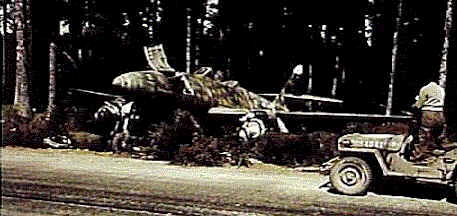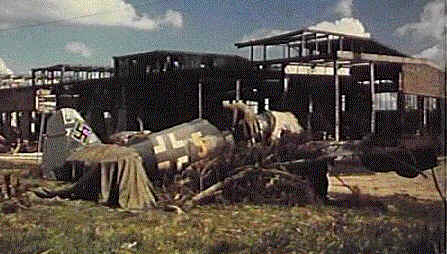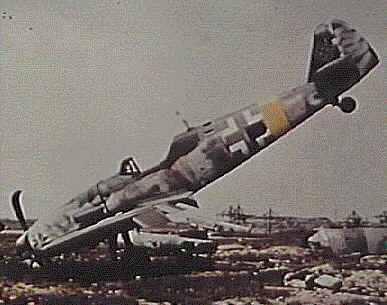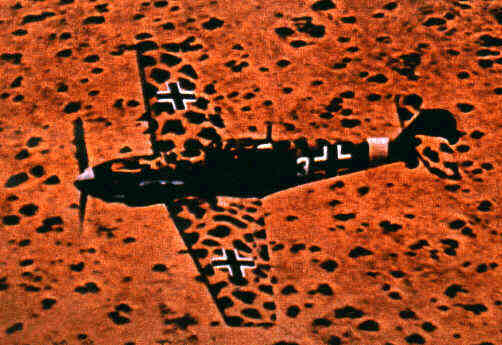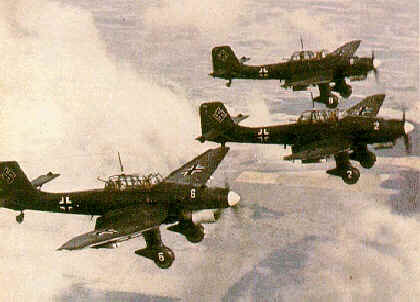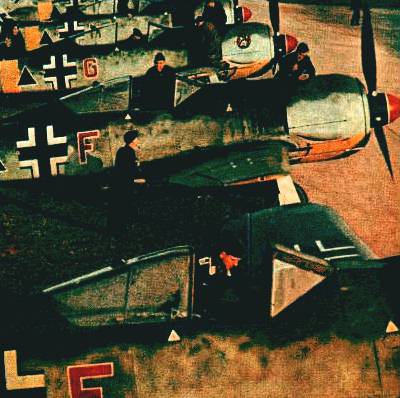World War II German Aircraft in Color
About the poorest quality color photo one can imagine (yes, it is in color, only very faded). The aircraft is a Messerschmitt Bf-109 G-10. The characteristic bulged cowling introduced by the G-10 series is apparent. Other than that, various G-10s could differ considerably in configuration, and this picture can server as a proof. This particular fighter has retained the old G-6 style undercarriage with ”thin” tyres and no overwing bulges. The tail wheel is also od older type with short leg. This could indicate that the machine is an early production G-10. However, the engine is believed to be the new DB 605 DM, as indicated by the enlarged oil cooler fairing and small blister just in front and below of the exhaust stacks.
The picture has been taken after the end of hositilities in spring 1945.
Not much can be said about the camouflage scheme except that it was two-tone on the upper surfaces. The mottlig on the fuselage sides is very pronounced, built of small solid blotches of paint.
Another interesting color feature is that the wooden propeller blades appear to be in light color, standing out in a strong contrast with the black spinner. Therefore is is unlike that they were painted in any of the dark green colors prescribed as factory standard.
Even the wheel hubs, which are commonly assumed to be painted black on all German aircraft, appear too light on the photograph to be black in color.
Andy Sattler added:
The Me 109 on the picture is definetly a G-10/R3. I could find the same picture in b/w but in a better quality. The engine is a DB 605 DM (with MW 50-Gerät) with the big Fo 987 oil cooler and the big VDM 9-12159 A propeller.
It is an aircraft of the Werknummernblock 130 000 – 130 500, 490 000 – 491 000 or 491 000 – 491 500. These machines were delievered from Octiber 1944 as the first of the G-10 series. Many of them where a/c with the AS-engine, only few got the new DB 605 DM. The delievered units were:
– III./JG 1
– I. and II./JG 1
– III./JG 4
– III./JG 6
– III./JG 51
– III./JG 52
– II. and IV./JG 27
– I. and II./JG 77
– I., III. and IV./JG 300
– II./NJG 11
– I./KG(Jagd) 6
The picture was taken in early May 1945 at the airfield of Salzburg-Maxglan, Austria. In the last days of World War II a part of former JV 44, redesigned in JG 7, was stationed along tree Staffeln of I./II./IV./JG 300 in Salzburg-Maxglam. All units capitulate there. I. and IV./JG 300 were equipped with G-10s. So there is a very high possibility of that this bird was used by JG 300.
This overexposed shot is a post-war photograph of the Messerschmitt Me 410A-3. The aircraft served with 2/(F)122 in Italy and had been captured intact in 1944 by advancing US forces. It was later taken to USA for flight evaluation test, being allocated an FE (Foreign Evaluation) number FE-499.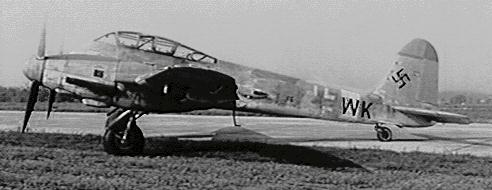
The camouflage and markings displayed are genuine, carried by the aircraft under it’s Luftwaffe service. The most prominent color of the camouflage here is RLM 76 Hellblau. This covers all undersurfaces, spinners, fuselage sides and vertical tail. The upper wing surfaces cannot be seen, but it is apparent that the top of the fuselage has been mottled with some darker gray color. It is believed that this mottle consists of only, or mostly, RLM 75 Grauviolett. It should be noted, however, that applying the general knowledge about the Me 410 paint schemes, is should be suspected that the upper camouflage consisted of RLM 75 and RLM 74 Dunkelgrau. This is not obvious on the color photograph, but can be seen better on the other black-and-white picture of the same aircraft to the right (note the mid-rear fuselage spine).
The aircraft carries unit markings F6+WK, where ”F6” is visible only by means of a small stencil in front of the fuselage cross, probably partially worn out. The cross is white outline only, with a mottled pattern showing inside it, and a swastika is of more conservative style, black thinly outlined with white. There is also a white fuselage band beneath ”W”, typical for the Luftwaffe in the Mediterranean theatre, but it has been either heavily worn out or partially overpainted with RLM76. Strangely, the band appears to be in better shape on the b-&-w photo, whereas the cross appears much better on the color one! The author welcomes any logical explanation to this.
The propeller blades are painted in standard RLM70 Schwartzgrun. Other point of interest is a black rectangular manufacturer’s plate at the engine cowling, just above the exhaust pipes. Plates like this wer4e located on port sides of both engine nacelles, but not on repeated on starboard. The undercarriage legs appear to be painted RLM02 Grau, and wheels in some darker color, possibly glossy dark grey.
Another funny observation is that the top of the fin appears to be of darker color on the black-and-white photograph, but turns out to be just a fresher tone of RLM76 on the color picture. If we didn’t have access to the color photograph, many would probably say that this area was painted yellow…
This unique photograph from the ending period of the war shows a Messerschmitt Me 262A of JV44 abandoned by retreating Germans. The photo has been taken after U.S. forces overran the airfield, as can be seen by the Willys Jeep and a soldier standing at the right. The place is Hofoldinger forest adjacent to the Salzburg-Munich Autobahn where a number of JV 44’s aircraft were hidden.
Although not visible, this aircraft carried a Werk Nummer 111685, and had been formerly marked 9K+FH of KG 51 which later went to JV 44.
Although the color quality isn’t really good enough to tell, the camouflage pattern of this aircraft is believed to consist of RLM 76 Lichgrau undersurfaces and fuselage sides. The fuselage sides had then been heavily mottled with RLM 81 Braunviolett/RLM 83 Hellgrun) colors – the green color is visible at the fuselage nose, whereas the area below the cockpit have been treated mostly with a brownish shade.
This picture has been most certainly taken after the end of hostilities. The aircraft is a late mark Bf 109 (K? late G?) with enlarged wooden tail. The fuselage number is ”Yellow 5”. Black band immediately behind the fuselage cross indicates that the fighter belonged to JG 53.
Some sources state that the location of this picture is Henschel Aero Engine Works in Attenbaum near Kassel and that the aircraft belonged to 3./JG53.
Good quality color photo shows an example of late-war German fighter camouflage. It is believed to be RLM 81/82 Braunviolett/Dunkelgrun upper and non-standard ”Sky” green-grey lower surfaces with a very limited or simply non-existent mottle on the fuselage sides. The existence of ”Sky” color on late-war Luftwaffe fighters has been widely disputed, but nowadays it is generally accepted that such a color (or colors) existed. This photograph shows it’s presence on the fuselage sides around the ”5”.
Of note is also that the Dunkelgrun color appears to be darker in shade than the interpretation of RLM 82 that can be found in many today’s’ reference books on the subject. Compare even with the next photo below!
The vertical tail carries a different style camouflage than the fuselage. The fin could be just damaged, but it might as well be painted RLM 76 Lichgrau with the brush-applied blotches of green, in this case probably RLM 82 Dunkelgrun. Consequently, the rudder would be painted RLM 82 overall. The differing style of camouflage is typical for late-production Bf 109s, when sub-contractors were ordered to fully paint their subassemblies prior to the final construction at the mother factory.
The fuselage cross is typical for the Late-war period, consisting only of the white outline with inner color ”borrowed” from the surrounding camouflage color, in this case Braunviolett
Another heavily damaged Bf 109G-14 was found like this in spring of 1945 outside the Messerschmitt factory at Regensburg. The aircraft lacks individual markings, but the yellow fuselage band would indicate that it belonged to JG 11.
The camouflage is most probably RLM 76 Hellgrau lower surfaces and fuselage sides and a combination of RLM 75 Grauviolett and RLM 82 Dunkelgrun on the fuselage top. The fuselage mottle had then been applied with the same colors, and RLM 76 on the RLM 82 tail.
Apparently, the mottle had been hastily applied, in large, local solid ”clouds” of color rather than uniform shading. This way of applying the fuselage mottle can be seen on other late Bf 109 manufactured at the Regensburg plant. Even worse, the rudder is decorated simply with a ”snake” pattern of airbrush-applied paint.
The fuselage cross is white outline with the inneer part in RLM 75
Another classic photo is this one, depicting a Messerschmitt Bf 109E-7/Trop low over the waters of Mediterranean Sea. Lt. Shroer is sitting in the cockpit, the aircraft itself belonging to 2./ JG27. The picture was taken during 1941. This particular aircraft has been described many times in various books, but many times in an inaccurate way as the authors apparently have been using black-and-white copies of the above picture.
The camouflage featured here is a typical early German desert scheme of RLM 79 Sandgelb upper surfaces with irregular blotches of RLM 80 Olivgrun. These have been applied very carefully, covering even canopy frames and antenna mast. Lower surfaces are often described as RLM 78 Azurblau. For my taste however, the color we can see on the picture could as well be RLM 76 Hellgrau. There is a standard white ”African” band on the tail and the aircraft carries standard crosses and a swastika on the tail. Black ”8” is outlined in red. Fuel octane triangle can be seen directly above it. Furthermore, there are some 4 kill markings in red on the top of the rudder, and Geschwader logo can be seen on the nose. The propeller spinner is half-black, half-white.
Of the aircraft construction, note that some panel lines are more visible than the others. In particular, the structural fuselage divisions at the engine firewall and just behind the cockpit are very prominent. Note also the rudimentary panel joint at the wing fillet.
For those who weather their models, note the oily graphite color of the desert oil filter. Directly below the ”8” can be seen an oil stain, which on all Emil tended to run all the way down the bottom of the rear fuselage and then spread itself up along fuselage panel lines by capillary action giving a characteristic ”fishbone” appearance.
The effectiveness of the above camouflage could hardly be better confirmed that by this picture. This is a ”White 3” of JG27 flying low over the desert in a sunset.
The basic camouflage pattern is the same as on the ”Black 8” above, with the exception that the green blotches on the wings are larger. The spinner is white/black even on this aircraft. The thin black outline appears to be missing from the wing crosses, but the white might have been retouched on the original photograph.
A formation of Junkers Ju 87B Stuka dive bombers has been photographed during the early months of operation Barbarossa (attack on the Soviet Union).
These aircraft wear an ordinary heavily-standardised and carefully-applied Luftwaffe bomber camouflage scheme. The upper colors are two greens: RLM 70 Schwarzgrun and RLM 71 Dunkelgrun. The lower surfaces are believed to be RLM 65 Hellblau, although not much blue color can be distinguished on this somewhat faded photograph. Propeller spinners are painted white in the forward portion and RLM71 in the back, as are the propeller blades.
Each individual aircraft carries a white identification number on the engine cowling, which has been repeated on the wheel spats. The crosses are of the pre-1936 standard, black with thin white outline. Even the swastikas are placed according to pre-1936 practice, in the middle of the tail, except for the middle aircraft which has it painted in the forward portion of the fin, and only this conforms to war-time markings regulations.
The line of Focke-Wulf Fw 190Gs photographed on Deblin-Irena airfield in the occupied Poland.
Filip Vermeulen wrote:
These are Fw-190 G types of II Gruppe, Schlachtgeschwader 2 ’Immelmann’, probably mid-1943. The unit, commanded by Major Heinz Frank, had been the first to equip with this ground-attack version in North Africa but moved to the Eastern Front (note the yellow theatre panels). Shown here are 5. Staffel aircraft, as indicated by spinner tips and letters painted in red. Several of the aircraft display the ’gun-toting Mickey Mouse’ emblem of the II Gruppe. (Source: Warplanes of the Luftwaffe – Aerospace publishing Ltd – UK)
Bryan Tucker added:
I also wish to note that the camoflage colors of these aircraft appear to be the standard RLM 74/75/76 mottle camoflage. Propellers were usually RLM 71 with spinners RLM 70 (but not in this case). It is also not unusual for these aircraft to have traces of RLM 02 gray intermixed in their side mottle. Cockpit interior was RLM 66 black gray.
World War II other Axis aircraft in Color
Italy
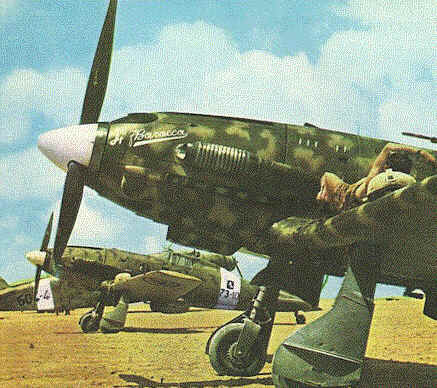 Yes, there are also some good color photographs of the Italian aircraft. This interesting picture presents two Macchi MC 202 Folgore, spotting two typical Italian day fighter camouflage patterns. The aircraft near the camera wears a ”Continental” scheme of dark olive green Verde Scuro upper surfaces with irregular blotches of sand yellow Sabbia. The other Macchi, as well as the Savoia-Marchetti SM 81 behind it wear a ”Desert” scheme in which the same colors have been reversed. The under surfaces are light grey Grigio Chiaro in both cases, and white spinners and fuselage bands are quick-recognition marking for the aircraft of the African campaign. Of interest is that the spinner of the ”Desert” Macchi seems to be an off-white color, ivory rather that pure white like the fuselage band. Please note also the individual inscription on the nose of the first aircraft, and the unit markings on the fuselage of the second machine.
Yes, there are also some good color photographs of the Italian aircraft. This interesting picture presents two Macchi MC 202 Folgore, spotting two typical Italian day fighter camouflage patterns. The aircraft near the camera wears a ”Continental” scheme of dark olive green Verde Scuro upper surfaces with irregular blotches of sand yellow Sabbia. The other Macchi, as well as the Savoia-Marchetti SM 81 behind it wear a ”Desert” scheme in which the same colors have been reversed. The under surfaces are light grey Grigio Chiaro in both cases, and white spinners and fuselage bands are quick-recognition marking for the aircraft of the African campaign. Of interest is that the spinner of the ”Desert” Macchi seems to be an off-white color, ivory rather that pure white like the fuselage band. Please note also the individual inscription on the nose of the first aircraft, and the unit markings on the fuselage of the second machine.
The aircraft seem to be in prefect condition, apart from the desert dust on the undercarriage, and the semi-gloss silky quality of the finish is clearly visible.
Japan
This bright and clear picture shows a Japanese Aichi M6A1 Seiran floatplane captured in this state of disorder by U.S. forces.
Don McIntyre was first with this comment:
I can’t provide any details, but the aircraft in question appears to be an Aichi M6A1 Sieran. Tamiya just released 1/72nd and 1/48th scale kits of the M6A1. Photo is definitely postwar.
Tom Gourlie added:
The Japanese floatplane appears to be an Aichi M6A1 Seiran. This is the plane that could be partially disassembled and launched from a submarine(after re-assembly, of course).
Mark Wlodarczyk wrote (translated from Swedish by Martin Waligorski):
A truly interesting photo! Correct, this is an Aichi M6A1 Seiran. The interesting part is that the green color goes around the fuselage undersides, normally these would be painted in light grey. It can also be seen that the lower wing and float surfaces are not rusty but painted in orange. This is obvious if you look at the thin white outline of the Hinomaru on the port wing.
The machine appears to be an experimental example, which is odd, as there had been a dedicated test variant of this aircraft, M6A2 (with wheels). I have never seen this photo before… I’ll send a link to it to the Japanese message board right away. I can get back with the exact color description if you want me to, but apparently the colors are standard IJNAF.
Too bad the fin with the code is gone!
Mark Wlodarczyk continued:
A friend from the Japanese forum gave me this:
The photo is also contained in Jeff Ethel’s last book (Pacific War Eagles). The caption reads:
”Army Air Forces personnel inspecting the Aichi aircraft factory in Nagoya came upon a real surprise, the sleek Aichi M6A1 Seran (Mountain Haze), an IJN Special Attack Bomber fitted with the company’s Atsuta 32 inverted V-12 inline 1,340 hp engine.”
There is more general history of the aircraft and the photo is credited to Mark H. Brown/USAFA
Furthermore:
This aircraft is an experimental airframe and had been painted orange overall from the beginning, leter on overpainted with green on the fuselage and wing upper surfaces. The code on the fin could in this case be something like ”C-A15”, where a ”C” should be a mirror-image an stands for a kana sign for ko.
It goes quickly on the Internet…
 A poor quality color photo, however an interesting one, as it shows some unusual aircraft! The two sleek Romanian I.A.R. 80 fighters fly in formation somewhere over the Eastern Front, as indicated by their yellow cowlings and fuselage bands. Judging from the numbers on the fins, the aircraft in the back is in fact an updated I.A.R. 81, but there were very few external differences between the two types. Not much can be said about the camouflage colors, but if you look closely on the nearest aircraft you will see that it carries an irregular two-tone camouflage of dark green and brown. The fuel octane triangles of Luftwaffe variety can be seen on top of the cowling. An interesting detail is a pitot tube painted in black and white stripes. Note also a factory logo in white on top of the fin.
A poor quality color photo, however an interesting one, as it shows some unusual aircraft! The two sleek Romanian I.A.R. 80 fighters fly in formation somewhere over the Eastern Front, as indicated by their yellow cowlings and fuselage bands. Judging from the numbers on the fins, the aircraft in the back is in fact an updated I.A.R. 81, but there were very few external differences between the two types. Not much can be said about the camouflage colors, but if you look closely on the nearest aircraft you will see that it carries an irregular two-tone camouflage of dark green and brown. The fuel octane triangles of Luftwaffe variety can be seen on top of the cowling. An interesting detail is a pitot tube painted in black and white stripes. Note also a factory logo in white on top of the fin.
aero@baynet.net commented:
This I.A.R. 80 photo appears in the book Horrido and the caption indicates they are on a training flight over the Southern Carpathians in June 1943.
This article was originally published in IPMS Stockholm Magazine in May 1998.


